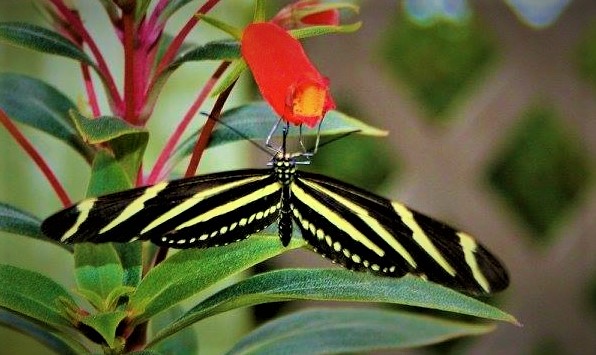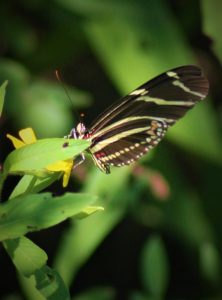
Photos by Romi White
The iconic Zebra Longwing butterfly is a common sight across the state of Florida, with its unmistakable black and pale-yellow flashes as it flutters lazily through forested landscapes or among suburban yards and parks. While widespread and familiar enough to be an excellent choice for our state butterfly, its biology and behavior is anything but ordinary.
Zebra Longwing pictured at Tom Brown Park in Tallahassee
Adult Zebra Longwings have several interesting traits that set them apart from other butterflies. While most species only live for a few weeks after metamorphosis, this species can live for several months. Their longevity can be partially explained by a unique feeding habit – rather than only living off nectar, Zebra Longwings can also use their saliva to dissolve and eat pollen. These butterflies have been shown to be remarkably intelligent; they can remember their favorite flowers to feed on and return again and again. At night, they can be found roosting in communal groups of up to 60 individuals.
Like many butterfly species, Zebra Longwings only lay eggs on specific host plants – in their case, the purple passionflower (also known as maypop). Their small yellow eggs hatch into white caterpillars with black spots and lots of black spines. As the caterpillars feed on the plant, they incorporate some of the passionflower’s naturally produced toxins, which makes them taste awful to potential predators. Passionflower is a very easy to grow native plant with stunning purple flowers, so planting some in your garden is an excellent way to attract Zebra Longwings to your yard. For more information on using native plantings to attract wildlife, you can order FWC’s Planting a Refuge for Wildlife booklet.
The Zebra Longwing is also the featured image on the first level Wings Over Florida butterfly certificate.
If you’ve spotted at least 10 butterfly or 50 bird species in the state, you can apply online today to receive your certificate in the mail.
































